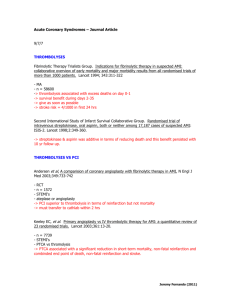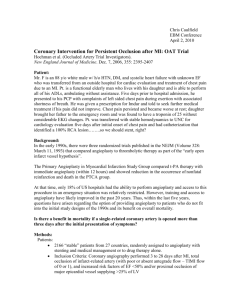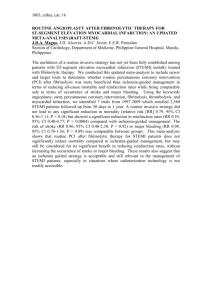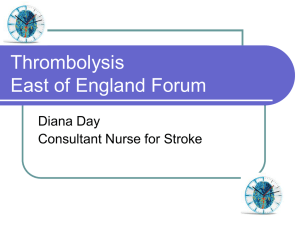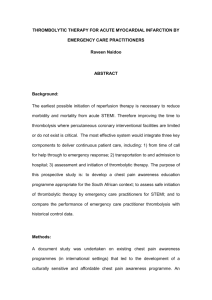Slides - Clinical Trial Results
advertisement
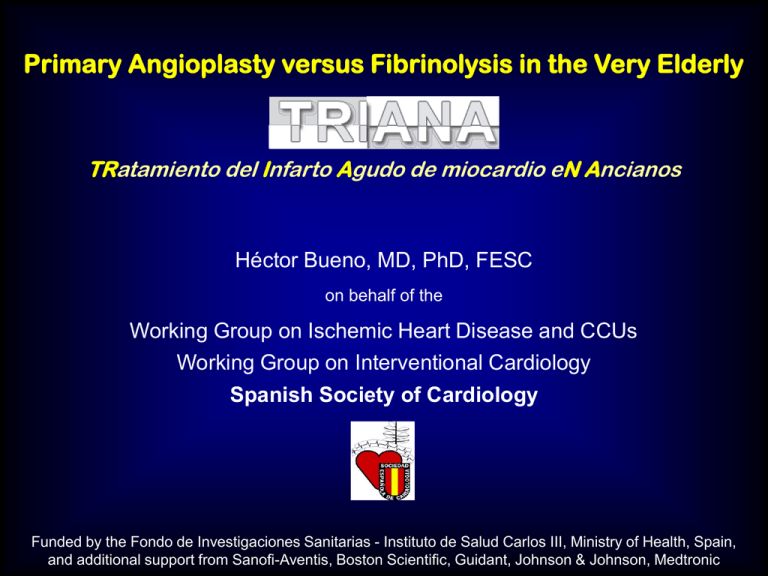
Primary Angioplasty versus Fibrinolysis in the Very Elderly TRatamiento del Infarto Agudo de miocardio eN Ancianos Héctor Bueno, MD, PhD, FESC on behalf of the Working Group on Ischemic Heart Disease and CCUs Working Group on Interventional Cardiology Spanish Society of Cardiology Funded by the Fondo de Investigaciones Sanitarias - Instituto de Salud Carlos III, Ministry of Health, Spain, and additional support from Sanofi-Aventis, Boston Scientific, Guidant, Johnson & Johnson, Medtronic Study Organization Sponsor: Spanish Society of Cardiology WG on Ischemic Heart Disease & CCUs WG on interventional Cardiology Steering Committee: Héctor Bueno (chair), Rosana Hernández-Antolín (co-chair), Joaquín J. Alonso, Amadeo Betriu, Angel Cequier, Eulogio J. Garcia, Magda Heras, Jose L. Lopez-Sendon, Carlos Macaya DSMB: José Azpitarte (chair) Adjudication Committee: Ginés Sanz (chair), Angel Chamorro, Ramón López-Palop, Alex Sionis, Fernando Arós Funding: Fondo de Investigación Sanitaria (grant # PI042122) Instituto Carlos III, Ministry of Health, Spain and unrestricted grants from: • Sanofi-Aventis • Boston Scientific • Guidant • Johnson & Johnson • Medtronic Background • Increasing population aging • Very old patients with STEMI more frequently admitted to CCUs • Primary PCI preferred therapy for STEMI patients in general • Scarce direct evidence for both reperfusion strategies in patients >75 years old Zwolle RCT in patients ≥75 years old 1.00 PA SK 0.95 Senior PAMI – Subgroup Age ≥80 years n = 87 patients 77 excluded 1996-1999 25 n=131 PA SK 20 0.90 15 % 0.85 P=0.04 0.80 10 P=0.96 P=0.72 P=0.57 5 0.75 0.70 0 0,5 1 1,5 2 Follow up (years) De Boer MJ. J Am Coll Cardiol 2002;39:1723-28. 0 Death Death / Dis. Stroke Death / Stroke / ReMI Grines C. Personal Communication. TCT, Washington, 2005 Background • Increasing population aging • Very old patients with STEMI more frequently admitted to CCUs • Primary PCI preferred therapy for STEMI patients in general • Scarce direct evidence for both reperfusion strategies in patients >75 years old Thrombolysis still the most frequently reperfusion therapy used over the world, including older patients • TRIANA Pilot Study Spanish Survey 26 Hospitals with active PA program March – July 2002 410 consecutive patients ≥75 years 100% 22.4 Primary Angioplasty 35.6 Thrombolysis 42.0 No reperfusion 80% 50% 25% 0% Bardají A. Rev Esp Cardiol 2005;58:351-8. Study Rationale Ayanian JZ, Braunwald E. Circulation 2000;101:2224-6. Thiemann DR. J Am Coll Cardiol 2002;39:1729–32. Keeley EC, de Lemos JA. Eur Heart J 2005;26:1693–4. Study Objective To compare the efficacy and safety of primary angioplasty and fibrinolytic treatment in patients 75 years-old with STEMI who are eligible for thrombolytic therapy in Spanish medical centres with an active program of primary angioplasty Study Design Patients ≥75 years STEMI / LBBB < 6 hours “optimal” candidates for TT TNK + UFH Weight adjusted Tenecteplase (TNK): Single weight-adjusted bolus Anticoagulation with UFH: Bolus 60 U/kg (maximum 4000 U) Infusion for aPTT x 1,5-2 (maximum 1000 U/h) No contraindications for TT + • No shock on admission • No single BP measured >180/110 mmHg • Never stroke / TIA Primary Angioplasty UFH 60 U/Kg (maximum 4000 IU) Abciximab Dependent on operator´s decission Clopidogrel LD dose 300 mg + MD 75 mg/day Clopidogrel (since Dec 06) 75 mg/day x 28 days Rescue PCI if no reperfusion criteria ↓>50% ST segment at 90´ + clínical data Urgent PCI (GPI discouraged) Coronary revascularisation only if evidence of recurrent myocardial ischemia (spontaneous/provoked) www.clinicaltrials.gov Study Design Patients ≥75 years STEMI / LBBB < 6 hours “optimal” candidates for TT TNK + UFH Weight adjusted Primary EndPoint No contraindications for TT + • No shock on admission • No single BP measured >180/110 mmHg • Never stroke / TIA Primary Angioplasty Death / MI / Disabling stroke at 30 days Death / MI / Disabling stroke at 12 months www.clinicaltrials.gov Analysis Sample size: 570 patients needed to detect with 80% power a 40% RRR (8.9% absolute risk difference) Randomisation: 24 hour central randomisation Analysis: Intention to treat Follow-up: Local - 100% End Point Adjudication: Blinded, by independent committee Endpoints Primary Incidence of the composite all-cause death, re-infartion or disabling stroke at 30 days Secondary • • • • • Recurrent ischemia requiring emergency cath at 30 days All-cause mortality at 30 days Cause of death at 30 days (pump failure/mechanical comp/other) Death, disabling stroke or new HF at 30 days Major bleeding during hospital admission • All-cause mortality at 12 months • Time to death, reinfarction or disabling stroke during FU • Time to death, reinfarction, disabling stroke or non-elective hospital readmission for cardiac causes during FU Inclusion Criteria 1. Subjects ≥ 75 years of age or older 2. Diagnosis of STEMI: chest pain or any symptom of myocardial ischemia of, at least, 20 minutes of duration, not responding to nitrate therapy, within first 6 hours from symptom onset and, at least, one of the following: • ST-elevation 2 mm in 2 or more precordial leads • ST-elevation 1 mm in 2 or more anterior leads • De novo (or probably de novo) LBBB 3. Informed consent Exclusion Criteria 1. Documented contraindication to the use of thrombolytics • Internal active bleeding or known history of hemorrhagic diathesis • History of previous stroke of any kind or at any time • Intracranial tumor, arteriovenous malformation, aneurysm or cerebral aneurysm repair • Major surgery, parenchymal biopsy, ocular surgery or severe trauma within 6 weeks prior to randomisation • Unexplained puncture in a non-compressible vascular location in the last 24 hours prior to randomisation • Confirmed arterial hypertension during the acute phase, previous to randomisation, with one reliable measurement of systolic BP >180 mmHg or diastolic BP >110 mmHg • Known thrombocytopenia < 100.000 platelets/L • Prolonged (>20 minutes) or traumatic cardiopulmonar resuscitation in the 2 weeks prior to randomisation • Symptoms or signs suggesting aortic dissection Exclusion Criteria 1. . 2. 3. 4. 5. Cardiogenic shock Estimated door-to-balloon time 120 minutes Administration of thrombolysis within 14 days prior to randomisation Administration of any GP IIa/IIIb inhibitor within 24 hours prior to randomisation Administration of any LMWH within 8 hours prior to randomization Current oral anticoagulant treatment Suspected AMI secondary to occlusion of a coronary lesion treated previously with PCI (within previous 30 days for conventional stents and within previous 12 months for DES) Dementia or acute confusional state at the time of randomisation Incapacity/unwillingness to give informed consent Known renal failure (basal creatinine> 2,5 mg/dl) Reduced expected life expectancy (<12 months) Participation in another RCT trial within previous 30 days 6. 7. 8. 9. 10. 11. 12. 13. Results: Recruitment • Study initiated in March 2005 • 23 hospitals participated • 266 patients were recruited • Study interrupted in December 2007 for slow recruitment Results: Baseline Characteristics Age (years) Gender (% males) Risk Factors (%) HTN Dyslipidemia Diabetes Current smoker Previous CVD (%) MI Stable angina PCI CHF PAD Thrombolysis n=134 Primary PCI n=132 81.2 ± 4.6 56.1 81.0 ± 4.3 56.7 59.1 27.3 34.1 15.2 67.9 41.8 * 26.1 11.2 7.6 13.6 3.8 9 10.4 5.2 0.8 9.1 1.5 10.4 *p=0.013 Results: Baseline Characteristics Thrombolysis n=134 Primary PCI n=132 180 (135 - 255) 180 (135 - 262) Admission SBP (mmHg) Admission DBP (mmHg) Admission HR (bpm) Killip class (% I / II / III) Anterior location (%) 132 ± 23 74 ± 13 73 ± 18 82 / 15 / 3 49 136 ± 25 75 ± 16 76 ± 18 84 / 11 / 3 42 Baseline Creatinine (mg/dl) Baseline Glucose (mg/dl) Baseline Hemoglobin (g/dl) 1.13 ± 0.34 176 ± 75 13.7 ± 1.9 1.09 ± 0.36 167 ± 81 13.8 ± 1.6 Time to randomisation (min) Results: Management Thrombolysis n=134 Times (min) Door to treatment Randomisation-treatmet Symptom onset-treatment Dose TNK (mg) UFH(%) Dose UFH bolus (U) Effective reperfusion (%) Urgent cath (%) Rescue PCI (%) 52 (32 - 72) 10 (5 - 15) 195 (150 - 270) Primary PCI n=132 99 (73 - 131) * 59 (35 - 75) * 245 (191 - 310) * 37 ± 6.1 78 3851 ± 729 - 74 16 15 *p<0.001 Results: Angiographic results and management Thrombolysis n=134 Primary PCI n=132 IRA: LM/LAD/CX/RCA (%) Pre-PCI lesion stenosis (%) TIMI flow pre-PCI 0/1/2/3 (%) - 1 / 42 / 14 / 37 96.4 ± 11.6 67 / 13 / 11 / 9 Stent (%) Dose UFH (U) GP Ib/IIIA inhibitors (%) IABP (%) - 84 5069 ± 1793 44 4.5 Post PCI stenosis (%) TIMI flow post-PCI (% 0/1/2/3) - 10.6 ± 25 6 / 2 / 10 / 82 Results: In-hospital treatments Aspirin Clopidogrel UFH LMWH GP lIb/III inhibitors iv GTN Beta-blockers ACEI Statins Diuretics Nitrates Inotropic agents Thrombolysis n=134 Primary PCI n=132 97 63 98 37 8 68 76 86 87 45 41 16 96 92 96 54 44 50 77 82 89 50 37 20 <0.001 0.006 0.003 0.004 Results: Primary Endpoint Death, reinfarction or disabling stroke incidence at 30 days % 30 OR 1.46 (0.81-2.61) P = 0.21 25 20 25.4 15 10 18.9 5 0 Primary Angioplasty Thrombolysis Results: Primary Endpoint components Death, reinfarction or disabling stroke incidence at 30 days % 20 Primary Angioplasty OR 1.31 (0.67-2.56) P = 0.43 Thrombolysis OR 1.60 (0.60-4.25) P = 0.35 15 OR 4.03 (0.44-36.5) P = 0.18 17.2 10 13.6 8.2 5 5.3 0.8 3.0 0 Death Reinfarction Disabling stroke Results: Other outcomes Primary Angioplasty % 20 Thrombolysis 15 OR 1.06 (0.49-2.03) P = 0.90 OR 14.1 (1.8-39) P < 0.001 OR 0.50 (0.19-1.31) P = 0.15 10 9.7 2.58 (0.79-8.45) P = 0.11 10.6 11.2 9.8 5 7.5 5.2 0.8 3.0 0 Recurrent ischemia CHF Shock Mechanical Comp. Results: Safety outcomes Primary Angioplasty % 20 Thrombolysis 15 OR 0.72 (0.29-1.77) P = 0.47 OR 1.26 (0.48-3.30) 10 5 P = 0.64 OR 0.55 (0.16-1.92) P = 0.35 OR 1.31 (0.67-2.56) P = 0.43 9.1 3.8 4.5 0 Major bleed* 5.3 6.7 6.1 7.5 3.0 Transfusion Major Bleed or Renal failure Transfusion * One ischemic stroke in TT arm at day 7, after elective PCI hemorrhaghic conversion 24 hours later Results: 12-month outcomes All-cause mortality 1.0 1.0 Cummulative Survival Cummulative Survival free of death reMI or diasbling stroke Composite endpoint 0.8 P=0.31 0.6 0.8 P=0.65 0.6 0 60 120 180 240 300 Follow-up (days) 360 0 60 120 180 240 300 Follow-up (days) 360 Results: 12-month outcomes Thrombolysis Primary PCI n=134 n=132 Death/ReMI/Disabling stroke Death ReMI Disabling stroke Urgent rehospitalisation Recurrent ischemia New HF Major bleeding 32.1 23.1 10.4 3.0 14.3 11.9 14.9 5.2 27.3 21.2 8.3 0.8 13.7 0.8 14.4 6.1 OR (95%CI) 1.26 (0.74-2.14) 1.12 (0.63 - 1.99) 1.28 (0.56 - 2.9) 4.03 (0.44 - 36.5) 1.05 (0.52 – 2.1) 17.8 (2.3 – 136.0) 1.04 (0.53 – 2.1) 0.85 (0.3 - 2.43) Conclusions • TRIANA did not prove (due to lack of power), but is consistent with, a superiority of primary angioplasty in reducing death, reinfarction and disabling stroke compared with thrombolysis in very old patients with STEMI. • Primary angioplasty is superior to thrombolysis in reducing reintervention due to recurring ischemia. • Whether the potential early advantage of primary angioplasty is mantained during follow-up needs to be explored • Thrombolysis can be performed with an acceptable risk of intracerebral bleeding in such patients Participating Investigators and Centers Hospital - City PI Cath Lab PI CCU Hospital Gen. Univ. “Gregorio Marañón” - MadridEulogio García-Fernández Rafael Rubio Hospital 12 de Octubre - Madrid Felipe Hernández Juan Carlos Tascón Hospital Virgen de la Salud -Toledo José Moreu José Moreu Hospital Clínic - Barcelona Amadeu Betriu Magda Heras Hospital Clínico San Carlos - Madrid Rosana Hernández-Antolín Antonio Fernández-Ortiz Hospital Central de Asturias - Oviedo César Morís Ignacio Sánchez de Posada Hospital Bellvitge - Barcelona Ángel Cequier Enrique Esplugas Hospital Univ. Virgen de las Nieves - Granada Rafael Melgares Rafael Melgares Hospital Univ. de Canarias - Las Palmas Francisco Bosa Martín Jesús García-Glez Hospital de Navarra - Pamplona Román Lezaún José Ramón Carmona Hospital Juan Canalejo - A Coruña José Manuel Vázquez Alfonso Castro-Beiras Hospital Santa Creu i Sant Pau - Barcelona Joan García Picart José Domínguez de Rozas Hospital Juan Ramón Jiménez - Huelva José Díaz Fernández José Díaz Fernández Complejo Hospitalario - León Felipe Fernández Vázquez Norberto Alonso Hospital Marqués de Valdecilla - Santander José Javier Zueco Chema San José Hospital Clínico Universitario - Valladolid Alberto San Román Carolina Hernández Hospital Virgen de la Victoria - Málaga José Mª Hernández García Ángel García Alcántara Hospital Univ. Son Dureta - Palma de Mallorca Armando Bethencourt Miquel Fiol Hospital Cruces - Bilbao Xabier Mancisidor Xabier Mancisidor Hospital Virgen de la Macarena - Sevilla Rafael Ruiz Rafael Hidalgo Hospital Universitario La Paz - Madrid Nicolás Sobrino Isidoro González Hospital Txagorritxu - Vitoria Alfonso Torres Fernando Arós Hospital Universitario - Santiago de Compostela Antonio Amaro Michel Jaquet Definitions (1) Reinfarction Within first 24 hours: Recurrent symptoms of ischemia at rest accompanied by new or recurrent ST-elevation > 0.1 mV in, at least, 2 or more adjacent leads for at least 30 minutes. After first 24 hours: Presence of new Q-waves in 2 or more leads or increase of CK, CK-MB or troponine levels higher than the upper limit of normal or greater than anticipated levels. Disabling stroke: Presence of new permanent focal or generalized neurologic symptoms affecting the normal life of a patient, associated to abnormal findings in CT scan or MRI (ischemic or hemorrhagic lesions) Heart failure: Presence of new symptoms/signs after the first 24 hours suggesting heart failure (dyspnea, orthopnea, S3, rales on pulmonary auscultation associated to signs of pulmonary congestion in chest X.-ray) Recurrent ischemia: Cardiac catheterization indicated for angina with STsegment deviation or T-wave inversion, provided that reinfarction criteria are not fulfilled. Definitions (2) Shock: presence of hypotension (systolic blood pressure < 90 mmHg without body fluids response accompanied with signs of low cardiac output) Mechanical complication: Clinical evidence of severe mitral regurgitation secondary to total/partial rupture of a papillary muscle, rupture of intraventricular septum or rupture of left ventricular free wall confirmed by any diagnostic technique. Major bleeding: Cerebral hemorrhage or any bleeding associated with a hemoglobin drop ≥ 5 gr/dL, or an absolute hematocrit drop ≥15%
